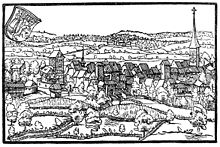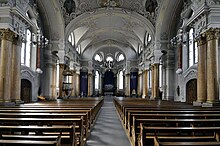City Church St. Nikolaus (Frauenfeld)
The Roman Catholic town church of St. Nikolaus Frauenfeld is one of the most important examples of neo-baroque sacral architecture in the canton of Thurgau . It stands on a molasse rock above the Murgbogen , in a prominent location.
history
History and naming

The first church buildings in the urban area of Frauenfeld go back to the 9th century. After the church of St. Laurentius in the Oberkirch district of Frauenfeld, a chapel has been attested at the current location of the town church of St. Nicholas since 1285 at the latest . The namesake of the chapel, St. Nicholas of Myra , is documented for the year 1463. During this time, several renovations changed the appearance of the chapel.
The Reformation, introduced in Frauenfeld in 1529, brought about extensive changes. For the St. Nicholas Chapel, as well as for the Laurentius Church, the two denominations established equal usage in 1531. This phase ended with the construction of the Protestant church in 1647. The alterations of 1648 affected the nave, it was completely rebuilt, the choir and church tower were preserved.
The first city fire of 1771 not only destroyed half of the city, there was also little left of the St. Nicholas Church, only the tower shaft had survived. The builder Peter Bein built the new building, which was consecrated in 1781 and which escaped the second city fire of 1788.
Development and construction history
During the second half of the 19th century, the number of residents and thus also the Catholics in Frauenfeld rose sharply. The old town church of St. Nicholas, with 600 seats, was increasingly too small to accommodate all the believers. In his report of October 1, 1890, August Hardegger came to the conclusion that it was not possible to simply lengthen the nave on the existing property, and proposed a west-facing, neo-baroque church building. However, the financial situation of the parish at that time did not allow the plans to be implemented.
A new dynamic around the church building arose in 1893 when plans of the city of Frauenfeld became known to build a new access road from the train station to the government building of the young canton of Thurgau, for which land from the area of the church was to be claimed. To prevent this and to end the lack of space, the dean Konrad Kuhn in particular pushed the new building project forward. The discussions became particularly sharp when Albert Rimli made a counter-proposal to Hardegger's project in 1895. According to Rimli's plans, the east-facing building was based very much on Hardegger's proposal. In the protracted, hateful arguments, the locally much better supported Rimli was able to prevail. He also succeeded in doing this thanks to the new design of a multifaceted building, which he presented as a precise perspective drawing, effectively staged. The parish assembly decided on November 8th, 1903 to rebuild the city church. After the laying of the foundation stone on July 10, 1904, the Catholic town church of St. Nicholas was consecrated on November 18, 1906.
Building description
Exterior
The basic concept of the St. Nikolauskirche consists of a west-facing, wide nave flanked by narrow side aisles , which are emphasized by baroque-style cliff windows . The choir with attached sacristy closes off the church space in the west. A transept divides the main axis after three fifths of the length. It is not very expansive, but contributes a lot to the strong structure of the facade and the church interior. The side entrance portals have been relocated to the transept.
The front side forms the main portal in the east of the church. This is elevated by the mighty church tower. The exterior is richly structured with pilaster strips , consoles and volutes . The stone facade bears a relief of plinths and cornices. The portals are dominated by the portal attachments and the ten larger-than-life external figures of saints.
For the ringing , it was decided, in cooperation with the Protestant parish, for the two city churches to ring together . The Rüetschi bell foundry in Aarau produced the bells for St. Nicholas in the main tuning of D flat major .
inner space
The main portal leads under the tower into the vestibule. Above it, the organ loft supported by pairs of columns forms the end until the ceiling with the large barrel vault widens over the main nave. On both sides the aisles are delimited by a series of paired columns. The transept divides the interior space and widens it at the transition to the side portals. The high windows of the side aisles and the kidney-shaped upper cladding windows let in plenty of light. Stucco work accentuate the room design and further emphasize the division.
During the renovation in 1967, the former color scheme, which was characterized by brown-red, white and golden tones, was given up in favor of today's multicolor. Another interior renovation took place from April to November 2015.
Furnishing
organ
The first organ in the town church, consecrated in 1906, was the op. 288 by Carl Theodor Kuhn . It was a pneumatic instrument with 37 resp. 39 registers on 3 manuals and pedal . The prospectus was designed by the architect Rimli.
Today's organ from 1969 comes from Metzler Orgelbau . It comprises 44 registers on three manuals (Hauptwerk, Brustwerk, Rückpositiv ) and the pedal , playing and stop action are mechanical. Planning and design were carried out by Bernhardt Edskes .
|
|
|
|
||||||||||||||||||||||||||||||||||||||||||||||||||||||||||||||||||||||||||||||||||||||||||||||||||||||||||||||||||||||||||||||||||||||||||||||||||||||||||||||||||||||||||||||||||||||||||||||||||||||
- Coupling : I / II, III / II, I / P, II / P
Peal
A 6-part bronze bell hangs in the tower of St. Nikolaus, which was cast in 1906 by the Rüetschi bell foundry (Aarau). The bells hang on steel yokes in a steel bell cage and have the chimes b 0 , 1 , es 1 , g 1 , b 1 and 2 .
literature
- Beatrice Sendner: bulwark of faith, lighthouse of immortal life, center of love. The neo-baroque town church St. Nikolaus in Frauenfeld (1904–1906) . In: Office for the preservation of monuments of the Canton of Thurgau (ed.): Preservation of monuments in Thurgau . tape 16 . Schwabe, Basel 2014, ISBN 978-3-7965-3355-6 .
- Hans Peter Mathis: How the Frauenfeld St. Nicholas Church got its neo-baroque shape - 80 years of St. Nicholas Church . In: Thurgauer Volkszeitung . Frauenfeld December 6, 1986, p. 8-9 .
Web links
- Stadtkirche St. Nikolaus on the site of the parish St. Anna Frauenfeld
Individual evidence
- ↑ a b c d e f g h i Beatrice Sendner: Bulwark of faith, lighthouse of immortal life, center of love. The neo-baroque town church St. Nikolaus in Frauenfeld (1904–1906). In: Preservation of monuments in Thurgau. Volume 16, 2014.
- ↑ Organ portrait on the website of the builder company; Retrieved June 25, 2015.
- ↑ Angelus Hux: Frauenfeld, Catholic town church St. Nikolaus. In: Angelus Hux, Alexander Troehler: Sound Spaces - Churches and Organs in Thurgau. Huber, Frauenfeld 2007. pp. 189-195; here p. 190/192.
- ↑ Information on the organ
- ↑ Video recording of the peal on YouTube
Coordinates: 47 ° 33 '25.7 " N , 8 ° 53' 52.5" E ; CH1903: 709.83 thousand / 268400




